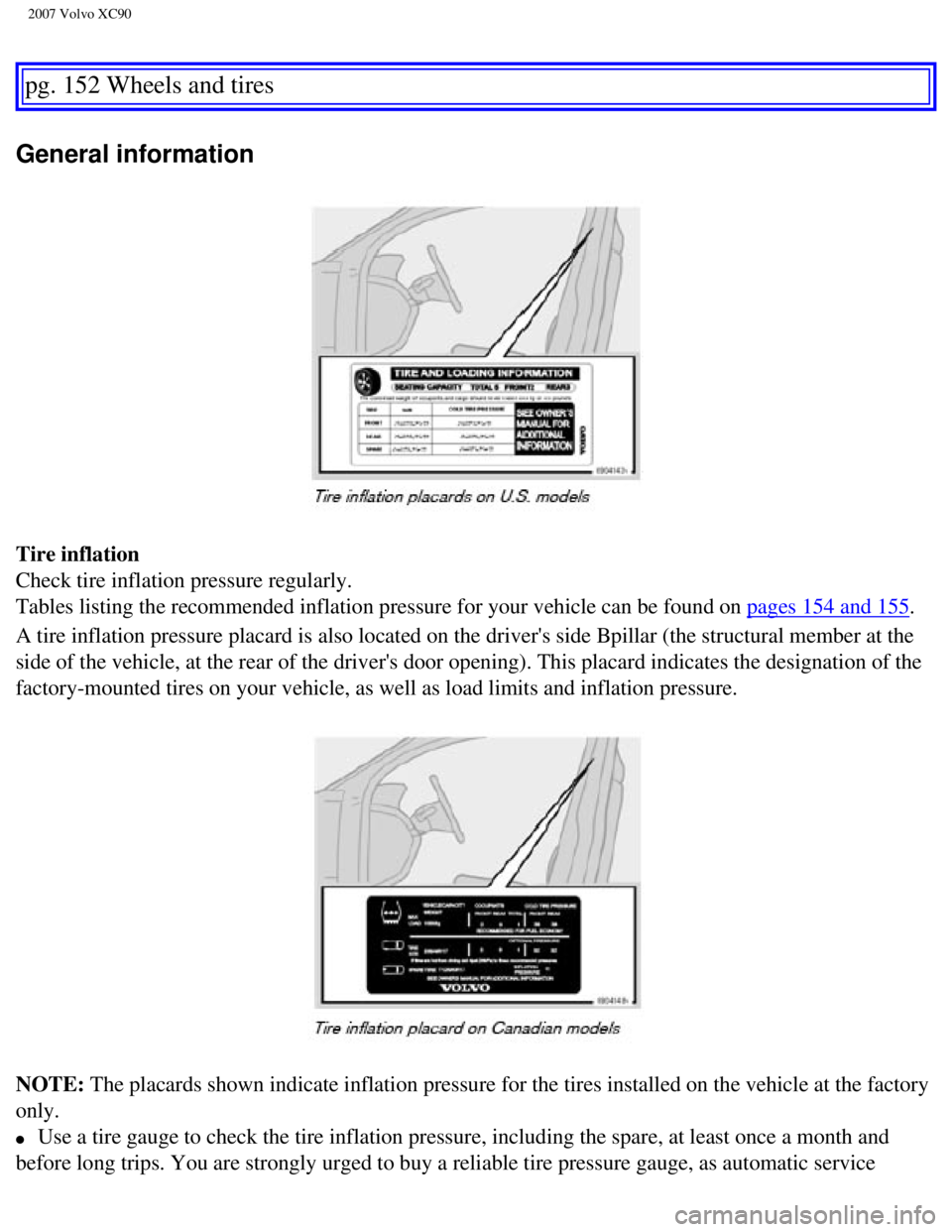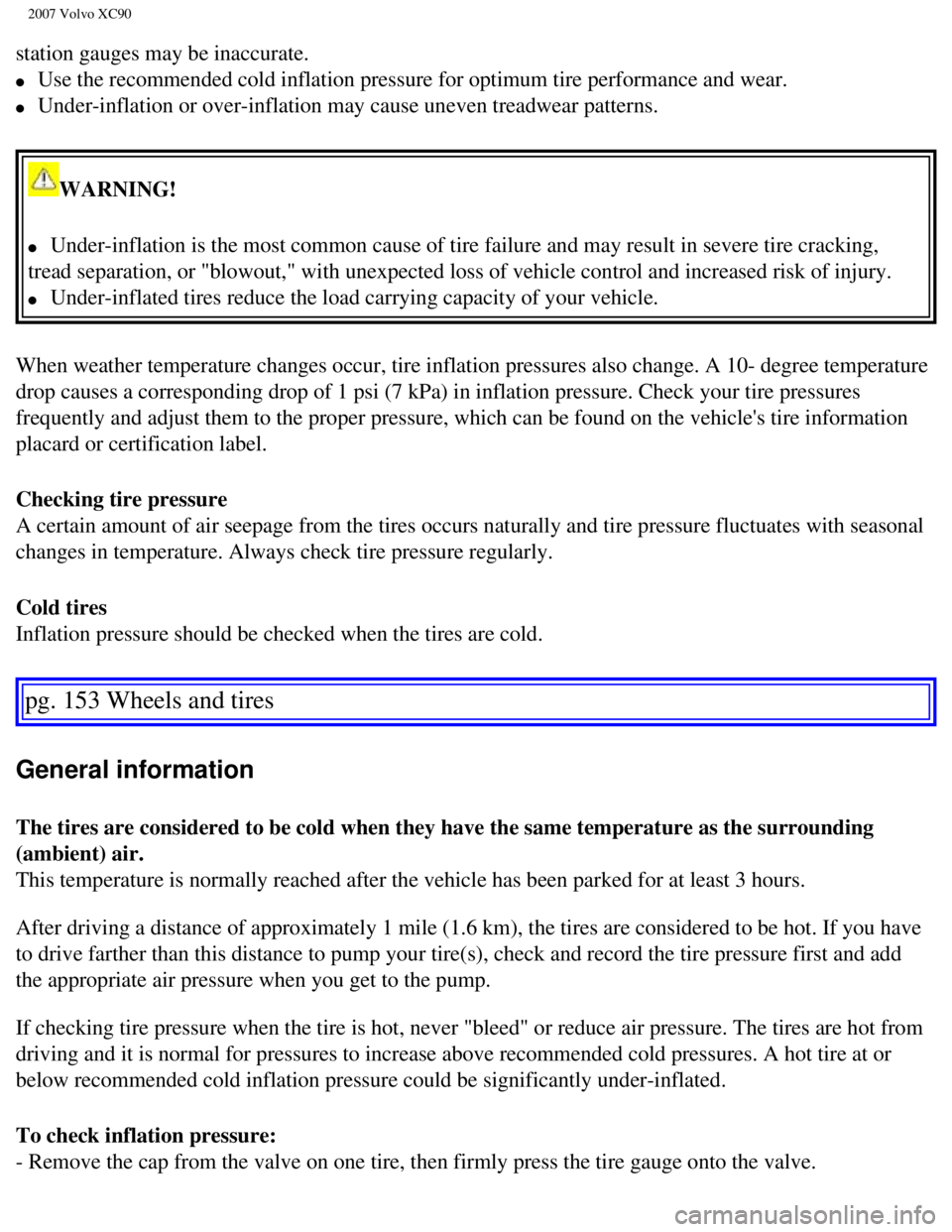2007 VOLVO XC90 tires
[x] Cancel search: tiresPage 147 of 268

2007 Volvo XC90
Towing a trailer
The maximum weights recommended by Volvo for trailers with brakes are shown in the table below.
NOTE:
l Recommended hitch tongue load: not more than 10% of the trailer's weight\
. The trailer load should be positioned
so that it does not shift and the tongue load should be 10% of the trail\
er's weight. However, the tongue load should not
exceed the maximum permissible weights indicated in the table above.
l When towing trailers without brakes, the maximum permissible trailer weight is 1,700 lbs (750 kg).\
l If necessary, redistribute the weight of any cargo in the trailer to avo\
id excessive weight on the trailer hitch.
l The maximum trailer weight listed in the table for All Wheel Drive model\
s, 5,000 lbs (2250 kg) is only applicable when
there are not more than two occupants in the vehicle, in the front seats\
, with a combined weight of 300 lbs (135 kg), with
no other cargo in the vehicle.
l The maximum weight listed for Front Wheel Drive models, 4,000 lbs (1800\
kg) is only applicable when there are not
more than four occupants in the vehicle, in the front seats and second r\
ow of seats, with a combined weight of 600 lbs (270
kg), with no other cargo in the vehicle.
pg. 138 Starting and driving
Towing a trailer
l Please be aware that the load on the trailer hitch is part of the vehicl\
e's total load carrying capacity. The amount of cargo
in the vehicle and the trailer must be limited so that the gross vehicle\
weight and maximum permissible rear axle weight
(see
page 209) are not exceeded.
l Vehicles used for towing a trailer on a regular basis, or for long-dista\
nce highway towing should be equipped with an
automatic transmission oil cooler and Volvo's automatic self-leveling sy\
stem for the rear suspension. Consult your Volvo
retailer.
l Volvo recommends the use of Volvo trailer hitches that are specially des\
igned for the vehicle.
l All Volvo models are equipped with energy-absorbing shock-mounted bumper\
s. Trailer hitch installation should not
interfere with the proper operation of this bumper system.
l Increase tire pressure to recommended full inflation pressure. See chapt\
er "Wheels and tires."
l When your vehicle is new, avoid towing heavy trailers during the first 6\
20 miles (1,000 km).
l Engine and transmission are subject to increased loads. Therefore, engin\
e coolant temperature should be closely
file:///K|/ownersdocs/2007/2007_XC90/07xc90_06.htm (23 of 32)12/30/200\
6 5:53:44 PM
Page 151 of 268

2007 Volvo XC90
Load carrier cover
The vehicle's ignition key or the stud on the edge of the supplied torqu\
e wrench can be used to undo or tighten the cover.
Turn a quarter turn (90 degrees). See illustration.
pg. 143 Starting and driving
Cold weather precautions
If you wish to check your vehicle before the approach of cold weather, t\
he following advice is worth noting:
l Make sure that the engine coolant contains 50 percent antifreeze. Any ot\
her mixture will reduce freeze protection. This
gives protection against freezing down to -31°F (-35°C). See sec\
tion "Coolant". The use of "recycled" antifreeze is not
approved by Volvo. Different types of antifreeze must not be mixed.
l Volvo recommends using only genuine Volvo antifreeze in your vehicle's r\
adiator. Your Volvo retailer stocks plenty of
Volvo engine coolant to protect your vehicle during cold weather.
l Try to keep the fuel tank well filled - this prevents the formation of condensation in the tank. \
In addition, in extremely
cold weather conditions it is worthwhile to add fuel line de-icer before\
refueling.
l The viscosity of the engine oil is important. Oil with low viscosity (thinner oil) improves cold-weat\
her starting as well
as decreasing fuel consumption while the engine is warming up. For winte\
r use, 5W-30 oil, particularly the synthetic type
1,
is recommended. Be sure to use good quality oil but do not use cold-weat\
her oil for hard driving or in warm weather. See
section "Engine oil" for more information.
l The load placed on the battery is greater during the winter since the windshield wipers, lighting, etc\
. are used more
often. Moreover, the capacity of the battery decreases as the temperatur\
e drops. In very cold weather, a poorly charged
battery can freeze and be damaged. It is therefore advisable to check th\
e state of charge more frequently and spray an
antirust oil on the battery posts.
l Volvo recommends the use of snow tires on all four wheels for winter driving - see section "Wheels and tires."\
l To prevent the washer fluid reservoir from freezing, add washer solvents containing antifreeze (see page 188 for the
location of the washer fluid reservoir). This is important since dirt i\
s often splashed on the windshield during winter
driving, requiring the frequent use of the washers and wipers. Volvo Was\
her Solvent should be diluted as follows:
- Down to 14° F (-10° C): 1 part washer solvent and 4 parts water
- Down to 5° F (-15° C): 1 part washer solvent and 3 parts water
- Down to 0° F (-18° C): 1 part washer solvent and 2 parts water
- Down to -18° F (-28° C): 1 part washer solvent and 1 part water
l Use Volvo Teflon Lock Spray in the locks.
NOTE: Avoid the use of de-icing sprays as they can cause damage to the locks.
file:///K|/ownersdocs/2007/2007_XC90/07xc90_06.htm (27 of 32)12/30/200\
6 5:53:44 PM
Page 152 of 268

2007 Volvo XC90
W - Winter/Wet driving mode - enhanced vehicle traction
l Mode W will only function if the gear selector is in the (D)rive position.
l Press the button at the base of the gear selector to engage/disengage th\
is driving mode.
l An LED in the button will light up to indicate that W is engaged and thi\
s will also be displayed in the instrument panel
(see
page 46).
l This mode may be selected for starting/ moving off on slippery roads.
1. Synthetic oil is not used when the oil is changed at the normal maint\
enance service intervals except at owner request and at
additional charge. Please consult your Volvo retailer.
pg. 144 Starting and driving
Before a long distance trip
It is always worthwhile to have your vehicle checked at a Volvo retailer\
before driving long distances. Your retailer will
also be able to supply you with bulbs, fuses, spark plugs and wiper blad\
es for your use in the event that problems occur.
As a minimum, the following items should be checked before any long trip\
:
l Check that engine runs smoothly and that fuel consumption is normal.
l Check for fuel, oil, and fluid leakage.
l Check transmission oil level1.
l Check condition of drive belts.
l Check state of the battery's charge.
l Examine tires carefully (the spare tire as well), and replace those th\
at are worn. Check tire pressures.
l The brakes, front wheel alignment, and steering gear should be checked b\
y your Volvo retailer only.
l Check all lights, including high beams.
l Reflective warning triangles are legally required in some states/provinc\
es.
l Have a word with your Volvo retailer if you intend to drive in countries\
where it may be difficult to obtain the correct
fuel.
l Consider your destination. If you will be driving through an area where \
snow or ice are likely to occur, consider snow
tires.
1. To prevent injury from contact with hot surfaces, do not inspect your\
vehicle's transmission fluid yourself. Have your vehicle's
transmission fluid level inspected by a qualified Volvo service technici\
an.
pg. 145 Starting and driving
Blind Spot Information System (BLIS) - option
file:///K|/ownersdocs/2007/2007_XC90/07xc90_06.htm (28 of 32)12/30/200\
6 5:53:44 PM
Page 157 of 268

2007 Volvo XC90
2 0 0 7
VOLVO XC90
Wheels and tires
pg. 149 Wheels and tires
General information 150
Tire inflation pressure tables - U.S. models
154
Tire inflation pressure tables - Canadian models
155
Tire Pressure Monitoring System (TPMS) -
option
156
Tire designations
159
Glossary of tire terminology
160
Vehicle loading
161
Uniform Tire Quality Grading
163
Snow chains, snow tires, studded tires
164
Temporary spare
165
Changing wheels
166
pg. 150 Wheels and tires
General information
Your vehicle is equipped with tires according to the vehicle's tire info\
rmation placard on the B-pillar
(the structural member at the side of the vehicle, at the rear of the d\
river's door opening), or on the inside
of the fuel filler door on Canadian models.
The tires have good road holding characteristics and offer good handling\
on dry and wet surfaces. It
should be noted however that the tires have been developed to give these\
features on snow/ice-free
surfaces.
Certain models are equipped with "all-season" tires, which provide a som\
ewhat higher degree of road
holding on slippery surfaces than tires without the "all-season" rating.\
However, for optimum road
file:///K|/ownersdocs/2007/2007_XC90/07xc90_07.htm (1 of 23)12/30/2006\
5:53:47 PM
Page 158 of 268

2007 Volvo XC90
holding on icy or snow-covered roads, we recommend suitable winter tires\
on all four wheels.
When replacing tires, be sure that the new tires are the same size desig\
nation, type (radial) and
preferably from the same manufacturer, on all four wheels. Otherwise the\
re is a risk of altering the
vehicle's roadholding and handling characteristics.
Storing wheels and tires
When storing complete wheels (tires mounted on rims), they should be s\
uspended off the floor or placed
on their sides on the floor.
Tires not mounted on rims should be stored on their sides or standing up\
right, but should not be
suspended. CAUTION!
Tires should preferably be stored in a cool, dry, dark place, and should\
never be stored in close
proximity to solvents, gasoline, oils, etc.
Tread wear indicator
The tires have wear indicator strips running across or parallel to the t\
read. The letters TWI are printed on
the side of the tire. When approximately 1/16" (1.6 mm) is left on the\
tread, these strips become visible
and indicate that the tire should be replaced. Tires with less than 1/16\
" (1.6 mm) tread offer very poor
traction.
When replacing worn tires, it is recommended that the tire be identical \
in type (radial) and size as the
one being replaced. Using a tire of the same make (manufacturer) will \
prevent alteration of the driving
characteristics of the vehicle.
pg. 151 Wheels and tires
file:///K|/ownersdocs/2007/2007_XC90/07xc90_07.htm (2 of 23)12/30/2006\
5:53:47 PM
Page 159 of 268

2007 Volvo XC90
General information
WARNING!
l The wheel and tire sizes for your Volvo are specified to meet stringent \
stability and handling
requirements. Unapproved wheel/tire size combinations can negatively aff\
ect your vehicle's stability
and handling. Approved tire sizes are shown in the Tire inflation pressu\
re tables on
page 154.
l Any damage caused by installation of unapproved wheel/tire size combinat\
ions will not be covered
by your new vehicle warranty. Volvo assumes no responsibility for death,\
injury, or expenses that
may result from such installations.
New tires
Remember that tires are perishable goods. As of 2000, the manufacturing \
week and year will be
indicated with 4 digits (e.g. 1502 means that the tire illustrated was \
manufactured during week 15 of
2002).
Tire age
Tires degrade over time, even when they are not being used. It is recomm\
ended that tires generally be
replaced after 6 years of normal service. Heat caused by hot climates, f\
requent high loading conditions
or Ultra Violet (U.V) exposure can accelerate the aging process.
You should replace the spare tire when you replace the other road tires \
due to the aging of the spare.
A tire's age can be determined by the DOT stamp on the sidewall (see th\
e illustration above).
A tire with e.g., visible cracks or discoloration should be replaced imm\
ediately.
Improving tire economy:
l Maintain correct tire pressure. See the tire pressure table on page 154.
l Drive smoothly: avoid fast starts, hard braking and tire screeching.
l Tire wear increases with speed.
l Correct front wheel alignment is very important.
l Unbalanced wheels impair tire economy and driving comfort.
l Tires must maintain the same direction of rotation throughout their life\
time.
When replacing tires, the tires with the most tread should be mounted on\
the rear wheels to reduce the
chance of oversteer during hard braking.
Hitting curbs or potholes can damage the tires and/or wheels permanently\
.
file:///K|/ownersdocs/2007/2007_XC90/07xc90_07.htm (3 of 23)12/30/2006\
5:53:47 PM
Page 160 of 268

2007 Volvo XC90
pg. 152 Wheels and tires
General information
Tire inflation
Check tire inflation pressure regularly.
Tables listing the recommended inflation pressure for your vehicle can b\
e found on
pages 154 and 155.
A tire inflation pressure placard is also located on the driver's side B\
pillar (the structural member at the
side of the vehicle, at the rear of the driver's door opening). This pl\
acard indicates the designation of the
factory-mounted tires on your vehicle, as well as load limits and inflat\
ion pressure.
NOTE: The placards shown indicate inflation pressure for the tires installed \
on the vehicle at the factory
only.
l Use a tire gauge to check the tire inflation pressure, including the spa\
re, at least once a month and
before long trips. You are strongly urged to buy a reliable tire pressur\
e gauge, as automatic service
file:///K|/ownersdocs/2007/2007_XC90/07xc90_07.htm (4 of 23)12/30/2006\
5:53:47 PM
Page 161 of 268

2007 Volvo XC90
station gauges may be inaccurate.
l Use the recommended cold inflation pressure for optimum tire performance\
and wear.
l Under-inflation or over-inflation may cause uneven treadwear patterns.
WARNING!
l Under-inflation is the most common cause of tire failure and may result \
in severe tire cracking,
tread separation, or "blowout," with unexpected loss of vehicle control \
and increased risk of injury.
l Under-inflated tires reduce the load carrying capacity of your vehicle. \
When weather temperature changes occur, tire inflation pressures also ch\
ange. A 10- degree temperature
drop causes a corresponding drop of 1 psi (7 kPa) in inflation pressur\
e. Check your tire pressures
frequently and adjust them to the proper pressure, which can be found on\
the vehicle's tire information
placard or certification label.
Checking tire pressure
A certain amount of air seepage from the tires occurs naturally and tire\
pressure fluctuates with seasonal
changes in temperature. Always check tire pressure regularly.
Cold tires
Inflation pressure should be checked when the tires are cold.
pg. 153 Wheels and tires
General information
The tires are considered to be cold when they have the same temperature \
as the surrounding
(ambient) air.
This temperature is normally reached after the vehicle has been parked f\
or at least 3 hours.
After driving a distance of approximately 1 mile (1.6 km), the tires a\
re considered to be hot. If you have
to drive farther than this distance to pump your tire(s), check and re\
cord the tire pressure first and add
the appropriate air pressure when you get to the pump.
If checking tire pressure when the tire is hot, never "bleed" or reduce \
air pressure. The tires are hot from
driving and it is normal for pressures to increase above recommended col\
d pressures. A hot tire at or
below recommended cold inflation pressure could be significantly under-i\
nflated.
To check inflation pressure:
- Remove the cap from the valve on one tire, then firmly press the tire \
gauge onto the valve.
file:///K|/ownersdocs/2007/2007_XC90/07xc90_07.htm (5 of 23)12/30/2006\
5:53:47 PM